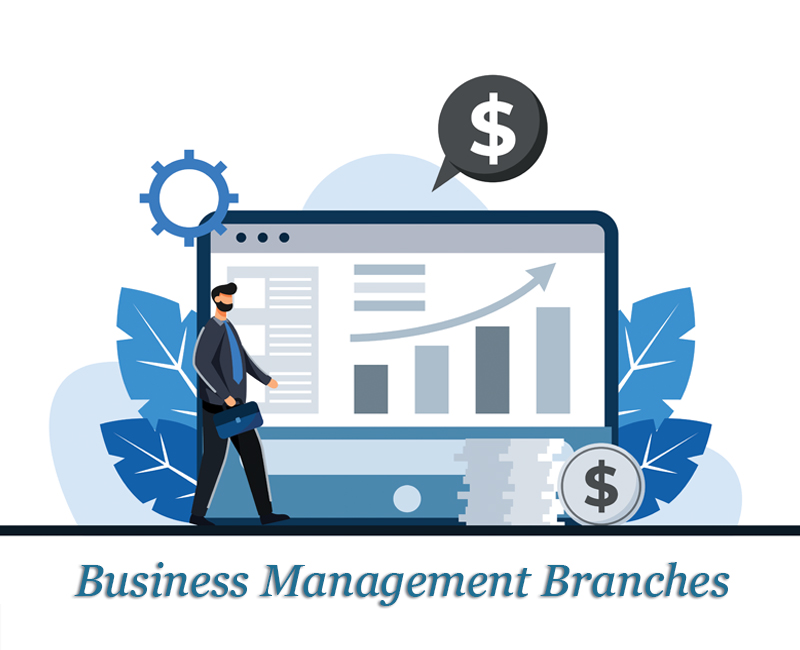More than 20 Branches in Business Management
If you think that business management is a single industry or career, you will undoubtedly change your mind after reading this article!
Business management is actually a comprehensive and diverse field comprising more than two dozen branches of business management, and in this article we’re talking over what you need to know about each branch…
1. Financial Management
Financial management is concerned with creating a healthy balance between profit and risk so that business profitability is attained even with hindrances.

The work in this type of management involves planning, directing, and coordinating activities such as accounting, investing, banking, insurance, securities, and other financial activities of a business. Financial management involves three main components:
- Financial Planning
- Financial Control
- Financial Decision Making
2. Marketing Management
Marketing management depends on a business’s size and industry. Marketing management invests in a company’s resources to increase its customer base and enhance the company’s perceived value and focuses on the practical application of marketing techniques and activities.
The four major analytical areas of marketing management are:
- Company analysis
- Collaborator analysis
- Competitor analysis
- Customer analysis
not forgetting brand, marketing strategy and pricing management.
3. Sales Management
Sales Management is about overseeing the sales teams. Sales managers train sales reps to enhance good relationships with prospects and convert them into a circle of constant customers. Sales management works hand in hand with marketing Management.
4. Human Resource Management (HRM)
Human Resources management is responsible for recruitment, training, security, and safety, as well as wages, compensation, rewards, and other aspects of managing an organization’s employees. In the past, human resource management was concerned more with personnel affairs, but recently HRM approach has become broader and uses employee programs and activities to make a positive impact on both the staff and the business as a whole.
5. Strategic Management
Strategic management generally focuses on WHERE you want to be, and HOW can you get there.
Strategic management is the application of strategic thinking in leading an organization. It is a competitive, flexible, and adaptive management, linked to other branches of management, and where the goals of the organization are formulated. The success of a business is often determined by financial, marketing, and operational strategies.
6. Production Management
It is concerned with transforming raw materials into a finished product or service.
Production management is the process of making decisions related to creating products and services, and it focuses directly on:
- Production Efficiency: involves the function of inventory control, which is the responsibility of production managers to monitor and follow up production elements, starting with raw materials and ending with final goods
- Research and Development: are two necessary processes for every organization that seeks to expand and improve its products
It is worth noting that production management techniques are used in industries such as manufacturing, service industries, and others…
7. Project management
Project management is concerned with planning, implementation, and then controlling projects. Project managers have tasks of exploring the tools and techniques needed to meet the current and future requirements of these projects.
Program management as well is concerned with the same tasks of project management, but for several projects at the same time not only for a single project.
8. Team Management
It is the supervision of all teams in an organization, and its function is concentrated mostly on project management and operation management.
Team management requires special skills and wide experience the team manager should have, such as organizing and coordinating a large number of employees, each performing a different function or job and leading them finally to achieve a specific result or goal.
9. Operational Management
Operations management is about ensuring that all sectors of business operations are efficient. Operations management of an organization means dealing with a lot of departments, strategies and processes, so operations teams should consider the acquisition, development and utilization of resources their business needs to deliver the goods and services clients want.
10. Service Management
The service management process enables a provider to understand its services from both the organization’s and the consumer’s perspective to ensure the features of the service are the desired outcomes of their clients. No matter how the service is managed-service providers need to manage the costs and risks involved, as well as the value and importance of the services to their clients… Sometimes, it is related to IT management, but it is more comprehensive, as it includes automated systems and skilled labor and often provides service development even if it is not IT related
11. Information Technology management
Monitoring and handling technology resources of an organization to meet its needs and priorities. Managers and teams of IT ensure a technology method is aligned with the company’s strategies and fulfilling customer expectations, and they focus on individual components and on using the best methods for reducing costs and improving employee efficiency. There are 3 major elements of IT management, IT configuration, IT service, and IT financial management.
12. Public Relations Management
In public relations management, the organization’s manager creates communications with public figures, primarily journalists, clients, and maybe other organizations that can inform the public about their organization’s latest news, products, and more. Public relations management strategies may vary by industry, but they have a consistent end goal: a strong public image.
13. Supply Chain Management
The supply chain management process controls how raw materials move from manufacturers, wholesalers, or other starting points to your organization. It is very important to ensure the quality of these raw materials because ultimately the organization uses them to create its products.
14. Procurement Management
Procurement management involves the acquisition of products from another entity or provider. It may also involve arrangements for services from third-party providers, and it usually focuses more on budgetary limits and deadlines than on the supply chain.
15. Research & Development Management
Research and development improve existing methods and explore and use new ways to gain advantages and make inventions that benefit the organization. Research and development management is the supervision of the efforts that adopt the development of the product or service as well as the development of the work team in order to raise the efficiency of the work.
16. Design Management
Design management is the monitoring of how products evolve from an idea to tangible items. However, managers of design focus equally on an item’s appearance and functionality, whereas R&D managers often give priority to function over form.
17. Quality Management
Quality management is to monitor the quality assurance tasks, and it involves product or service planning and quality policy, control, and improvement. After customers or clients use the product or service, a quality manager evaluates the improvements that users seek and lead the team to implement these changes.
18. Risk Management
Risk management involves evaluating works practices and identifying problem and error areas. Once potential flaws are identified, risk managers consult organization executives and other department heads to analyze and discuss how these risks can be minimized or avoided…
19. Investment Management
Investment management is concerned with the money market and labor market and involves the operations of managing financial assets such as bonds, stocks, and assets such as real estate in order to achieve profitable investments that provide proceeds for the investor or organization.
20. Change Management
Change management addresses a wide variety of organizational internal or external transitions and changes that aims to move from an existing situation to a planned target situation within through a clear vision. Change management is an important process and requires guiding teams through policy changes or the implementation of new teams. It can be broad, like assisting with organization mergers and acquisitions.
21. Innovation Management
Innovation management is the process of exploring a new or different thought or behavior, managing activities that produce new knowledge and technologies, evaluating them to extract creative values, and even coordinating the tasks of R&D, strategic, and change managers in order to streamline work toward the achievement of the organization goals.
22. Facilities Management
Facilities management is coordinating between buildings, and providing maintenance and cleaning services, security, safety, health, and technical support, in addition to fire protection and disaster systems. Facilities management combines many tasks with one aim of ensuring an integrated functional performance of facilities.
23. Facilities Management
Facilities management is coordinating between buildings, and providing maintenance and cleaning services, security, safety, health, and technical support, in addition to fire protection and disaster systems. Facilities management combines many tasks with one aim of ensuring an integrated functional performance of facilities.
Still, there are much more branches that you can check in the resources ..









